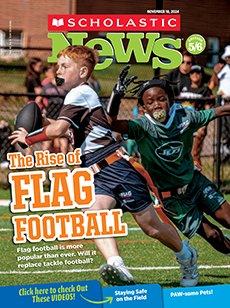Jim McMahon/Mapman®
The Games take place every four years. Athletes go head-to-head, hoping to bring home a gold medal. They compete in 16 sports, including swimming, volleyball, and basketball. Are these the Olympics? No. They’re the North American Indigenous Games (NAIG), where young athletes from 756 Native nations come together.
The 2023 NAIG took place last July in Halifax, Nova Scotia, in Canada. More than 5,000 Native athletes and coaches came from across North America. Although competitors battled it out in dozens of events over six days, the NAIG are about a lot more than sports.
Fifteen-year-old America Cackowski from Wisconsin competed in three track-and-field events. She is a member of the Oneida Nation. Before the NAIG, she hadn’t met a lot of people from other Native groups.
“At my school, there are not many kids from other nations—or many Native Americans at all,” America explains.
But at the NAIG, America and the other members of Team Wisconsin got to connect with many other Indigenous peoples. The athletes learned about different Native nations and shared their own traditions.
“I was proud to represent my culture and nation,” America says.
The Games take place every four years. Athletes go head-to-head against each other. They hope to bring home a gold medal. Athletes compete in 16 sports. This includes swimming, volleyball, and basketball. Are these the Olympics? No. They’re the North American Indigenous Games (NAIG). During the NAIG, young athletes from 756 Native nations come together.
The 2023 NAIG took place last July in Halifax, Nova Scotia. That’s in Canada. More than 5,000 Native athletes and coaches came from across North America. Competitors battled it out in dozens of events over six days. But the NAIG are about a lot more than sports.
Fifteen-year-old America Cackowski is from Wisconsin. She competed in three track-and-field events. She is a member of the Oneida Nation. Before the NAIG, she hadn’t met a lot of people from other Native groups.
“At my school, there are not many kids from other nations—or many Native Americans at all,” America explains.
But at the NAIG, America got to connect with many other Indigenous peoples. The other members of Team Wisconsin did too. The athletes learned about different Native nations and shared their own traditions.
“I was proud to represent my culture and nation,” America says.

